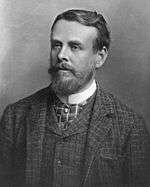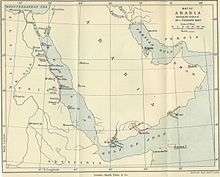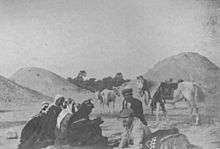James Theodore Bent
James Theodore Bent (30 March 1852 – 5 May 1897) was an English explorer, archaeologist and author.
James Theodore Bent | |
|---|---|
 James Theodore Bent | |
| Born | 30 March 1852 |
| Died | 5 May 1897 (aged 45) London, England |
| Nationality | English |

Biography
James Theodore Bent was the son of James Bent of Baildon House, near Bradford, Yorkshire, where he was born. He was educated at Repton School and Wadham College, Oxford, where he graduated in 1875. In 1877 he married Mabel Hall-Dare and she became his companion, photographer and diarist in all his travels. He went abroad every year and became thoroughly acquainted with Italy and Greece. In 1879 he published a book on the republic of San Marino, entitled A Freak of Freedom, and was made a citizen of San Marino; in the following year appeared Genoa: How the Republic Rose and Fell,[1] and in 1881 a Life of Giuseppe Garibaldi.[2] He spent considerable time in the Aegean archipelago, of which he wrote in The Cyclades; or, Life among the Insular Greeks (1885).[3][4][5]

Archaeological research
From this period Bent devoted himself particularly to archaeological research. The years 1885-1888 were given up to investigations in Asia Minor, his discoveries and conclusions being communicated to the Journal of Hellenic Studies and other magazines and reviews. In 1889 he undertook excavations in the Bahrein Islands of the Persian Gulf, and found evidence that they had been a primitive home of the Phoenician civilization. After an expedition in 1890 to Cilicia Trachea, where he obtained a valuable collection of inscriptions, Bent spent a year in South Africa, with the object, by investigation of some of the ruins in Mashonaland, of throwing light on the vexed question of their origin and on the early history of East Africa. In 1891 he made, with the surveyor Robert M.W.Swan, the first detailed examination of the Great Zimbabwe. Bent described his work in The Ruined Cities of Mashonaland (1892). In 1893 he investigated the ruins of Axum and other places in northern Ethiopia, which had previously made known in part by the researches of Henry Salt and others. His book The Sacred City of the Ethiopians (1893) gives an account of this expedition.[3]
Bent now visited at considerable risk the almost unknown Hadramut country (1893–1894), and during this and later journeys in southern Arabia he studied the ancient history of the country, its physical features and actual condition. On the Dhofar coast in 1894-1895 he visited ruins which he identified with the Abyssapolis of the frankincense merchants. In 1895 1896 he examined part of the African coast of the Red Sea, finding there the ruins of a very ancient gold-mine and traces of what he considered Sabean influence. While on another journey in South Arabia and Socotra (1896–1897), Bent was seized with malarial fever, and died in London on 5 May 1897, a few days after his return.[6][3]
Mabel, who had contributed by her skill as a photographer and in other ways to the success of her husband's journeys, published in 1900 Southern Arabia, Soudan and Sakotra, which she recorded the results of their last expedition into those regions. The conclusions at which Bent arrived as to the Semitic origin of the ruins in Mashonaland have not been accepted by archaeologists.[3]
Legacy
Bent is commemorated in the scientific name of a species of Arabian lizard, Uromastyx benti.[7]
Notes
- "Review of Genoa: How the Republic Rose and Fell by J. Theodore Bent". The Academy: A Weekly Review of Literature, Science, and Art. 19 (463): 200. 19 March 1881.
- Bent, J. Theodore (1882). The Life of Giuseppe Garibald (2nd ed.).
- Chisholm 1911.
- Bent, J. Theodore (1885). "The Cyclades; or, Life among the Insular Greeks". Cite journal requires
|journal=(help) - "Review of The Cyclades; or, Life among the Insular Greeks by J. Theodore Bent and Greek Folk Songs, trans. by Lucy M. J. Garnett, with an historical introduction on the survival of paganism by John S. Stuart Glennie". The Quarterly Review. 163: 204–231. July 1886.
- Bent explored the island of Socotra with Ernest Bennett, Fellow of Hertford College, Oxford. See The Island of Socotra, J. Theodore Bent, Nineteenth Century, June 1897, (published posthumously).
- Beolens, Bo; Watkins, Michael; Grayson, Michael (2011). The Eponym Dictionary of Reptiles. Baltimore: Johns Hopkins University Press. xiii + 296 pp. ISBN 978-1-4214-0135-5. ("Bent", p. 23).
References
| Wikimedia Commons has media related to Theodore Bent. |

- Carr, William (1901). . Dictionary of National Biography (1st supplement). London: Smith, Elder & Co.
External links
- Works by James Theodore Bent at Project Gutenberg
- Works by Mrs. Theodore Bent at Project Gutenberg
- Works by or about James Theodore Bent at Internet Archive
- Works by James Theodore Bent at LibriVox (public domain audiobooks)

- Theodore & Mabel Bent: Explorers By Nature (site devoted to their travels)
- An 1885 travel guide to Keos (Zea), an excerpt from The Cyclades: or Life among the Insular Greeks